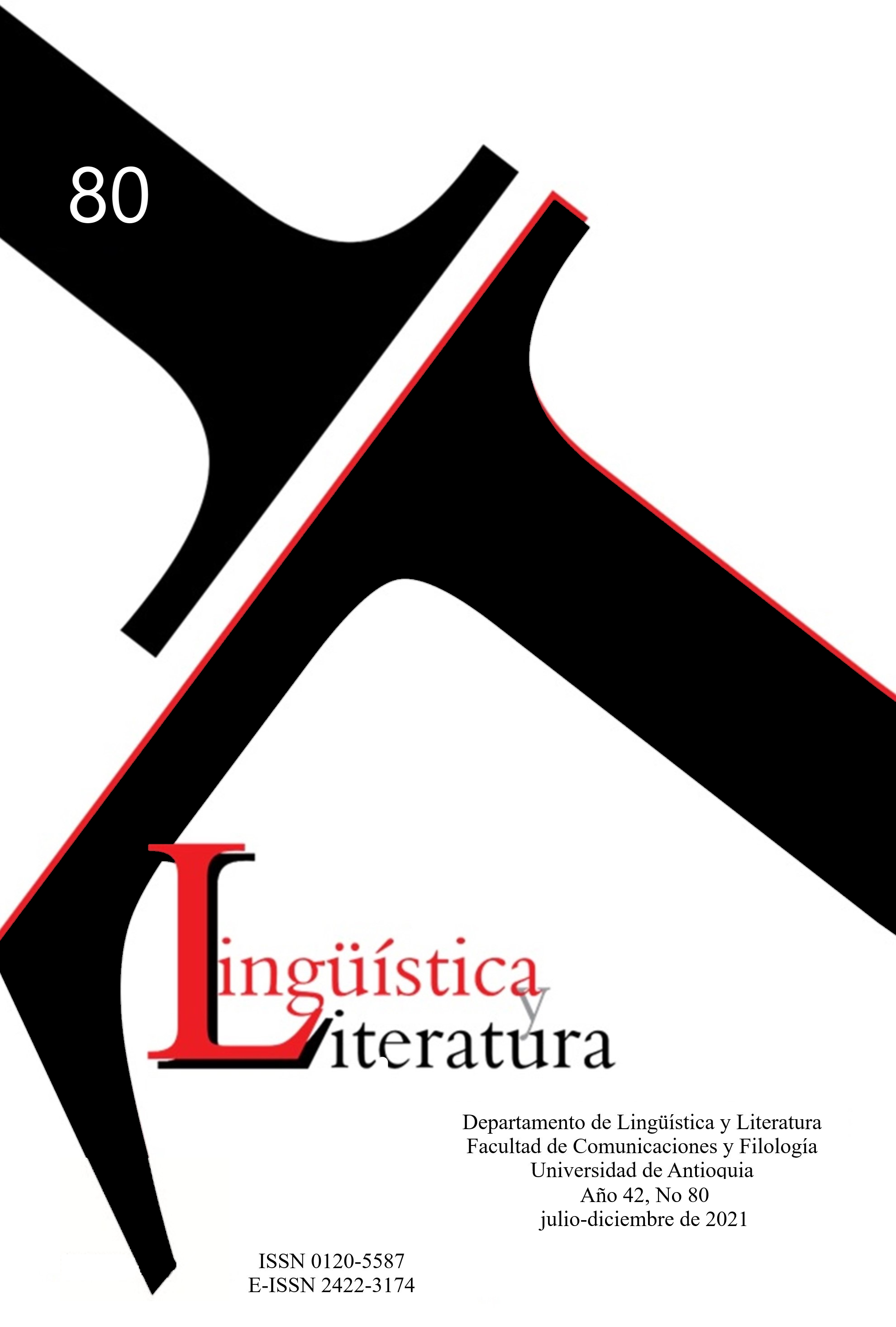Sobre el estudio biológico del lenguaje 50 años después. Una conversación con Noam Chomsky
DOI:
https://doi.org/10.17533/udea.lyl.n80a21Palabras clave:
Traducción, EntrevistaResumen
Artículo original titulado «50 Years Later: A Conversation about the Biological Study of Language with Noam Chomsky», publicado en la sección Forum de la revista Biolinguistics, 11, 2017, SI: 487–499, http://www.biolinguistics.eu. Entrevista traducida del inglés por Miguel Ángel Mahecha Bermúdez y Rubén Arboleda Toro.
Descargas
Citas
Arbib, Michael A. (2017) [este número]. Language and Brain: Developmental Aspects: Eric Lenneberg at theNeurosciences Research Program in 1972. Sección Biolinguistics.
Becker, Misha K. (2017) [este número]. Innate Mechanisms for Acquiring Syntactic Displacement. Sección Biolinguistics.
Bem, Daryl J. & Sandra L. B. (1968). Nativism Revisited: A Review of Eric H. Lenneberg’s Biological Foundations of Language. Journal of the Experimental Analysis of Behavior, 11(4), 497-501. doi:10.1901/jeab.1968.11-497.
Berwick, R. C. & Chomsky, N. (2016). Why Only Us? Language and Evolution. Cambridge, MA: MIT Press.
Berwick, R. C. & Stabler, E. (In press). Parsing with Minimalist Grammars. Oxford, England: Oxford University Press. [Berwick, Robert Edward Stabler (Ed.) 2019. Minimalist Parsing. NewYork, Oxford University Press.]
Bizzi, E. & Ajemian, R. (2015). A Hard Scientific Quest: Understanding Voluntary Movements. Daedalus, 144(1), 83-95. Doi: 10.1162/DAED a 00324.
Boeckx, C. &. Grohmann, K. (2007). The Biolinguistics Manifesto. Biolinguistics, 1, 1-8.
Chesi, C. & Moro, A. (2015). The Subtle Dependency between Competence and Performance. In Angel J. Gallego & Dennis Ott (Eds.), 50 Years Later: Reflections on Chomsky’s Aspects. Cambridge, MA: MITWPL. 33-45.
Chomsky, N. (1957/2002). Syntactic Structures (2nd edition.). Berlin: De Gruyter.
Chomsky, N. (1959). A Review of B. F. Skinner’s Verbal Behavior. Language, 35(1), 26-58.
Chomsky, N. (2016). What Kind of Creatures Are We? New York: Columbia University Press.
Christiansen, M. H., & Muller, R-A. (2015). Cultural Recycling of Neural Substrates during Language Evolution and Development. In M. S. Gazzaniga & G. R. Mangun (Eds.), The Cognitive Neurosciences v. (pp. 675-682). Cambridge, MA: MIT Press.
Friederici, A. D. (2017a). Language in Our Brain: The Origins of a Uniquely Human Capacity. Cambridge, MA: MIT Press.
Friederici, A. D. (2017b) [este número]. Neurobiology of Syntax as the Core of Human Language 325-338. Sección Brief.
Friederici, A. D., Chomsky, N., Berwick, R. C., Moro, A. & Bolhuis, J. J. (2017). Language, Mind and Brain. Nature Human Behaviour. Doi: 10.1038/s41562-017-0184-4.
Hauser, M. D. & Watumull, J. (2016). The Universal Generative Faculty: The Source of Our Expressive Power in Language, Mathematics, Morality, and Music. Journal of Neurolinguistics. DOI:10.1016/j.jneuroling.2016.10.005.
Lashley, K. S. (1951). The Problem of Serial Order in Behavior. In L. A. Jeffress (Ed.), Cerebral Mechanisms in Behavior (pp. 112-146). New York: Wiley.
Lenneberg, E. H. (1964). A Biological Perspective of Language. In E. H. Lenneberg (Ed.), New Directions in the Study of Language (pp. 65-88). Cambridge, MA: MIT Press.
Lenneberg, E. H. (1967). Biological Foundations of Language. New York: Wiley.
Lenneberg, E. H. (1972). Language and Brain: Developmental Aspects. A Report Based on an NRP Work Session Held November 19-21, 1972, and updated by participants. Neuroscience Research Programme Bulletin, 12(4), 511–656.
Marr, D. (1982/2010). Vision: A Computational Investigation into the Human Representation and Process. Cambridge, MA: MIT Press.
Martins, P. T. & Boeckx, C. (2016). What We Talk about when We Talk about Biolinguistics. Linguistics Vanguard, 2(1). doi: 10.1515/lingvan-2016-0007.
Piattelli-Palmarini, M. (2017) [este número]. From Zero to Fifty: Considerations on Eric Lenneberg’s Biological Foundations of Language and Updates, 423 -444, sección Forum
Merriam-Webster Dictionary (2021). Expatation. https://www.merriam-webster.com/dictionary/exaptation
Publicado
Cómo citar
Número
Sección
Licencia
Derechos de autor 2021 Lingüística y Literatura

Esta obra está bajo una licencia internacional Creative Commons Atribución-NoComercial-CompartirIgual 4.0.
Creative Commons by-nc-sa
Aquellos autores/as que tengan publicaciones con esta revista, aceptan los términos siguientes:
1. La revista es el titular de los derechos de autor de los artículos, los cuales estarán simultáneamente sujetos a la Licencia Internacional Creative Commons Reconocimiento-NoComercial-CompartirIgual 4.0. que permite a terceros compartir la obra siempre que se indique su autor y su primera publicación en esta revista.
2. Los autores/as podrán adoptar otros acuerdos de licencia no exclusiva de distribución de la versión de la obra publicada (p. ej.: depositarla en un archivo telemático institucional o publicarla en un volumen monográfico) siempre que se indique la publicación inicial en esta revista.
3. Se permite y recomienda a los autores/as difundir su obra a través de Internet (p. ej.: en archivos telemáticos institucionales o en su página web) antes y durante el proceso de envío, lo cual puede producir intercambios interesantes y aumentar las citas de la obra publicada.










